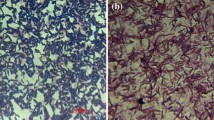Abstract
A combination of lactobacilli and biofilm-forming bacteria were evaluated in continuous fermentations for lactic acid production using various supports. Twelve different bacteria, including species of Bacillus, Pseudomonas, Streptomyces, Thermoactinomyces, and Thermomonospora were tested for biofilm-forming capabilities. Solid supports that were evaluated in either batch or continuous fermentations were pea gravels, 3M-macrolite ceramic spheres, and polypropylene mixed with 25% of various agricultural materials (e.g. corn starch, oat hulls) and extruded to form chips (pp-composite). Biofilm formation was evaluated by the extent of clumping of solid supports, weight gain and (in some instances) Gram stains of the supports after drying overnight at 70° C. The supports consistently producing the best biofilm were pp-composite chips followed by 3M-Macrolite spheres then by pea gravels. The best biofilm formation was observed with P. fragi (ATCC 4973), S. viridosporus T7A (ATCC 39115), and Thermoactinomyces vulgaris (NRRL B-5790), grown optimally at 25, 37, and 45° C, respectively, on various pp-composite chips. Lactic acid bacteria used in the fermentations were Lactobacillus amylophilus (NRRL B-4437), L. casei (ATCC 11443), and L. delbrueckii mutant DP3; these grow optimally at 25, 37 and 45° C, respectively. Lactic acid and biofilm bacteria with compatible temperature optima were inoculated into 50-ml reactors (void volume 25 ml) containing sterile pp-composite supports. Lactic acid production and glucose consumption were determined by HPLC at various flow rates from 0.06 to 1.92 ml/min. Generally, mixed-culture biofilm reactors produced higher levels of lactic acid than lactic acid bacteria alone. S. viridosporus T7A and L. casei on pp-composite chips were the best combination of those tested, and produced 13.0 g/l lactic acid in the reactors without pH control. L. casei produced 10.3 g/l lactic acid under similar conditions.
Similar content being viewed by others
References
ATCC (1989) American Type Culture Collection Catalogue of bacteria and bacteriophages, 17th edn. ATCC, Rockville, Md.
Atkinson B, Davies IJ (1972) The completely mixed microbial film fermenter. Trans Inst Chem Eng 50:208–216
Characklis WG, Marshall KC (1990) Biofilms. Wiley, New York
Crueger W, Crueger C (1990) A textbook of industrial microbiology. Sinauer Associates, Sunderland, Mass.
Demain AL, Solomon NA (1986) Industrial microbiology and biotechnology. American Society for Microbiology, Washington, D. C.
Demirci A, Pometto III AL (1992) Enhanced production of d( − )-lactic acid by mutants of Lactobacillus delbrueckii ATCC 9649. J Ind Microbiol (in press)
Holten CH, Muller A, Rehbinder D (1971) Properties and chemistry of lactic acid and derivatives. Verlag Chemie, Weinheim
Iwasaki KI, Nakajama M, Sasahara H (1992) Porous alumina beads for immobilization of lactic acid bacteria and its application for repeated-batch fermentation in soy sauce production. J Ferment Bioeng 73:375–379
Lipinsky ES, Sinclair RG (1986) Is lactic acid a commodity chemical? Chem Eng Prog 8:26–32
Ohleyer E, Wilke CR, Blanch HW (1985) Continuous production of lactic acid from glucose and lactose in a cell-recycled reactor. Appl Biochem Biotechnol 11:457–463
Ohleyer E, Blanch HW, Wilke CR (1986) Continuous production of lactic acid in a cell recycle reactor. Appl Biochem Biotechnol 11:317–331
Pometto III AL, Crawford DL (1986) The effects of pH on lignin and cellulose degradation by Streptomyces viridosporus. Appl Environ Microbiol 52:246–250
Roy TBV, Blanch HW, Wilke CR (1982) Lactic acid production by Lactobacillus delbrueckii in a hollow fiber fermenter. Biotechnol Lett 8:483–488
Stenrous SL, Linko YY, Linko P (1982) Production of l-lactic acid with immobilized Lactobacillus delbrueckii. Biotechnol Lett 4:159–164
Vega JL, Clausen EC, Gaddy JL (1988) Biofilm reactors for ethanol production. Enzyme Microb Technol 10:390–402
Zayed G, Zahran AS (1991) Lactic acid production from salt whey using free and sugar immobilized cells. Lett Appl Microbiol 12:241–243
Author information
Authors and Affiliations
Additional information
Journal paper no. J-14840 of the Iowa Agriculture and Home Economics Experiment Station, Ames Iowa. Project nos. 2889 and 0178
Correspondence to: A. L. Pometto
Rights and permissions
About this article
Cite this article
Demirci, A., Pometto, A.L. & Johnson, K.E. Evaluation of biofilm reactor solid support for mixed-culture lactic acid production. Appl Microbiol Biotechnol 38, 728–733 (1993). https://doi.org/10.1007/BF00167135
Received:
Accepted:
Issue Date:
DOI: https://doi.org/10.1007/BF00167135




